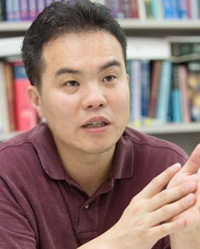- California Assembly OKs highest minimum wage in nation
- S. Korea unveils first graphic cigarette warnings
- US joins with South Korea, Japan in bid to deter North Korea
- LPGA golfer Chun In-gee finally back in action
- S. Korea won’t be top seed in final World Cup qualification round
- US men’s soccer misses 2nd straight Olympics
- US back on track in qualifying with 4-0 win over Guatemala
- High-intensity workout injuries spawn cottage industry
- CDC expands range of Zika mosquitoes into parts of Northeast
- Who knew? ‘The Walking Dead’ is helping families connect
Korean scientist develops new CO2-separating technology
By Kim Da-ye
Most Korean scientists who have published their discoveries in top international scholarly journals like Science and Nature, studied abroad either in the U.S. or Europe. Park Ho-bum, an associate professor of energy engineering at Hanyang University, is among the very few who are not part of this trend. He had his academic training in Korea, yet was able to publish his innovative findings in one of these acclaimed academic journals.
Park has so far published two papers in the Science journal. His latest thesis that went online at Science’s website on Oct. 4, is about the technology of separating carbon dioxide from nitrogen and hydrogen. If successfully adopted by the industry, it is expected to lower the cost of controlling greenhouse gases and ultimately dealing with climate change.
Park and his team developed the gas-separating membranes using graphene and graphene oxide. Graphene is an extremely thin sheet of carbon atoms connected in a hexagon pattern. It is often called a “wonder material” because of it’s strength, flexibility and stability.
His research succeeded in creating pores in graphene sheets and stacked multiple of them in a way that ensures that only carbon dioxide molecules get to travel between the layers and become separated.
Park and his team are the pioneers of this innovative method of gas separation, and they expect the technology to be deployed on a commercial scale in two or three years.
While the progress of the research has been swift, Park’s interest in graphene is very recent. He earned his bachelor’s, master’s and doctoral degrees in chemical engineering at Hanyang University. He did his postdoctoral fellowship at the University of Texas at Austin for three years between 2005 and 2008 during which he published his first paper in Science.
Park specialized in polymer science and became interested in membranes that are used for gas separation, water purifying and desalination. He experimented with various materials other than polymer which led him to work with graphene.
Educated only in Korea before his post-doctoral studies, Park was very much aware of the importance of studying abroad. He bumped into the Nature journal by chance, where he saw an advertisement about how publishing in the journal can enhance one’s chances of gaining an academic position in at a relatively young age. He started regularly reading both Science and Nature afterward with the aim of understanding what the journals looked for in researches ― innovations that surprise the world. Park became a professor at the age of 35.
Park says that it is every scientist’s dream to let the world know their research outcomes through Nature or Science. He said that the quality of domestic research facilities now matches those of global institutions, but Korean researchers should be more creative to come up with researches that can attract the attention of international scholarly journals.
“When I got the idea of graphene, the material was not within my expertise. I have not been only interested in my major, polymer, but also physics and chemistry. I think one should look into diverse disciplines. The new era demands the creative talents with integrated knowledge in various subjects,” Park said.
“People believe geniuses are creative. I don’t think so. The geniuses learn things fast. They have good brains. Creative people don’t just stick to textbooks. They always have questions and try to find answers through studying all fields of science and combining them.”












